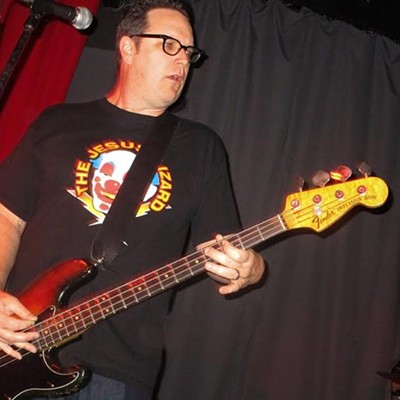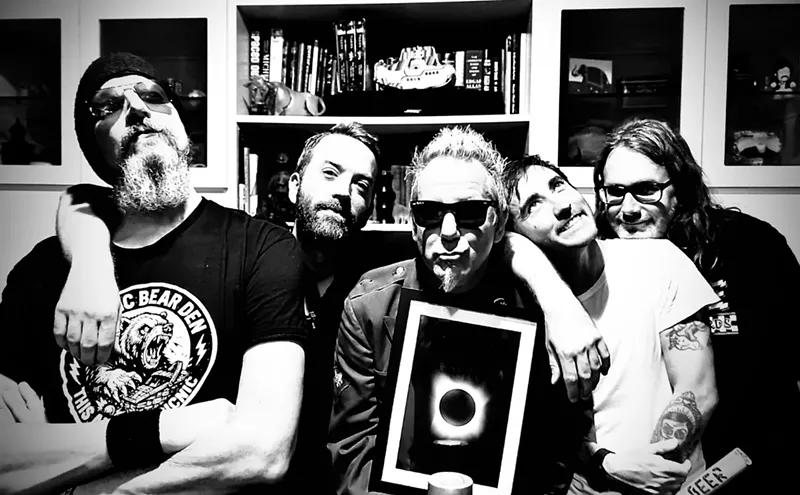I sit here listening to Mighty Sphincter's Ghost Walking EP as I get ready to write about Bob Dylan's 1966 classic, Blonde on Blonde, which recently celebrated its 50th birthday right around the time its author turned 75.
It's a strange mix, for sure. I wonder if any DJs out there have ever mixed a song off of Blonde on Blonde into a Mighty Sphincter song. If it hasn't happened yet, it should. Dylan probably never got down with any old Phoenix punk, but one never knows. It's pretty certain he had some influence, even if not directly, on at least a few of the classic Phoenix bands, punk and otherwise.
The numbers related to Dylan's record bounce around my head. 1966... 50 ... 75... They seem surreal with the weird instrumentation of Mighty Sphincter's Doug Clark, Joe Albanese, and Greg Hynes dancing around Ron Reckless' oddly Dylan-esque vocal phrasing. I couldn't help but choose this 1984 Phoenix weirdo punk record to cleanse my palette after a solid week of Blonde on Blonde action.
At the time Blonde on Blonde was written, Dylan was winding up one of the most prolific periods of his storied career. In the mid-'60s, Dylan was a busy man. One minute he's charming his way into the hearts of the folk rockers with an acoustic guitar, a harmonica, and one of the most easily identifiable vocal deliveries ever, and the next minute he's actively pissing off many of his fans by going all electric on them.
Blonde on Blonde captures this transition to electrified Dylan incredibly well. The album came out on the heels of 1965's double-shot of Dylan classics Bringing It All Back Home and Highway 61 Revisited, and picked up the creative pace considerably. Perhaps it was Dylan's inclusion of The Band guitar player Robbie Robertson for much of the Blonde on Blonde recording process that added the distinctive treble-heavy guitar that permeates many of the cuts, but Blonde on Blonde might be the best of the bunch.
To be honest, I have dabbled in Dylan at different times of my life and Highway 61 Revisited has been a steadfast member of my collection for a long, long time, but you'll find me listening to the likes of Mighty Sphincter or Jesus Lizard much more often than I'll put on some Bob. Recently, though, Robyn Hitchcock (The Soft Boys, the Egyptians, the Venus 3) inspired me to pick up Dylan's work again and give it another go.
Hitchcock spoke about how many performers and bands who have endured over the years tend to play a lot of the early catalogs when playing live because that's what fans want to hear, but this is not a trend for Dylan.
"Whereas with Bob Dylan, songs more than 20 years old kind of dissolve. They sort of lose their shape and obviously don’t really matter to him anymore," Hitchcock said. "His sets now, mostly, are with material from the past 20 years. I would rather see Dylan into his material. I’d rather watch that than have him massacre 'To Ramona' [from 1964's Another Side of Bob Dylan] or [from Highway 61 Revisited] 'Desolation Row.' He can deliver recent songs really sincerely and with the intensity you would expect from Dylan."
I reached out to Hitchcock for a comment or two about Blonde on Blonde, and he was happy to oblige.
"Blonde On Blonde is 50 now. Is she fading yet? No, she's as smoky and feline as ever. She curls up on your shoulder and breathes perfume and tobacco into your ear. Her speech is slurred but her voice is distinct: 'It balances on your head just like a mattress balances on a bottle of wine' [from "Leopard Skin Pill-Box Hat"],' she murmurs. Her fingers mimic a massage on the back of your neck and your skin breaks into goose bumps. 'This is what salvation must be like after a while,' [from "Visions of Johanna"] she observes, looking around. Her permed hair flares like a halo around her silhouetted head: Directly behind her is a Chinese lantern that you cannot see. How many times have you sat all night with her, in a half-embrace, in turbulence even on dry land? 'Infinity goes up on trial,' [also from "Visions of Johanna"] she smugly announces as she heads for a mysterious closet that you can never enter. After 50 years, her fascination breathes and smolders as fresh as a mint julep. She pours you a snake that writhes down your throat and turns to fireworks inside you: 'I could make it without you if I just didn't feel so all alone' [from 'Obviously Five Believers'].If you listen to some of Hitchcock's recent solo work, especially his 2014 effort, The Man Upstairs, the influence of Blonde on Blonde songs like "Sad-Eyed Lady of the Lowlands" and "Visions of Johanna" is more than apparent. As I immersed myself in the record, whether it was Dylan's lyrics, Robertson's guitar, or Al Kooper's ever-present (and stellar) keyboard work, the legacy of this American classic became more and more apparent.
Just before you pass out, she hands you the final card 'Who among them could ever think he could destroy you?' (from "Sad Eyed Lady of the Lowlands") and she's gone with a click and a hiss. But she never leaves you, only stays silent for a time in that cupboard of hers.
Her creator has wandered in time, grown old and calloused, taunted by a wisdom that came on him before experience. But that's another story."
Even though Dylan occasionally liked to chide them about it in song, Dylan's influence on John Lennon and the Beatles shines clearly on several tracks on Blonde on Blonde, most notably though, "4th Time Around." Dylan's last line has often been thought of as a dig at Lennon for aping his style. "And I, I never took much/I never asked for your crutch/Now don’t ask for mine," Dylan sang.
Ironically, the most instantly recognizable track on the album is arguably its worst. Opening track "Rainy Day Women #12 & 35" is not a terrible song, but it is the weakest link on the record. With it's catchy, stoned out marching band sound and refrain of "But I would not feel so all alone, everybody must get stoned," "Rainy Day Women" starts off the record in perhaps the most misleading way of any of the albums in Rolling Stone's top 10 of all time list.
"Stuck Inside of Mobile with the Memphis Blues Again" might be one of the best songs Dylan ever penned. There is something completely upbeat about the song, even though when you listen closely or even read the lyrics, you might easily become depressed. It is this knack of Dylan's, to tie some of the mopiest lyrics ever to his oddly (and weirdly infectious) poppy folk-rock riffs, that makes him inspiring to any songwriter. If there was no Bob Dylan, there would be no Velvet Underground, no REM, and no Smiths, and that is just naming a few.
How many other bands did those three bands inspire? It boggles the mind, just as Dylan's lyrics sometimes do at first listen. Dylan's work, on many levels, needs to marinate in the mind. Certainly "Rainy Day Women" and the album's other instantly recognizable song, "Just Like a Woman," are the exception from Blonde on Blonde, but this record is one that needs to be sipped and savored. If it were a bottle of scotch, you'd need to take out a second mortgage to buy it.
Some won't get this record, but in all honestly, what record out there is understood and appreciated by everybody? The beauty of it all is that Bob Dylan would probably just laugh and say something inaudible about the fact that I wrote this or you read it. Maybe he'd be a little stoked on how important his work is, even now, but like Hitchcock mentioned, there is an "intensity" with Dylan, and it doesn't just live in 1966.












